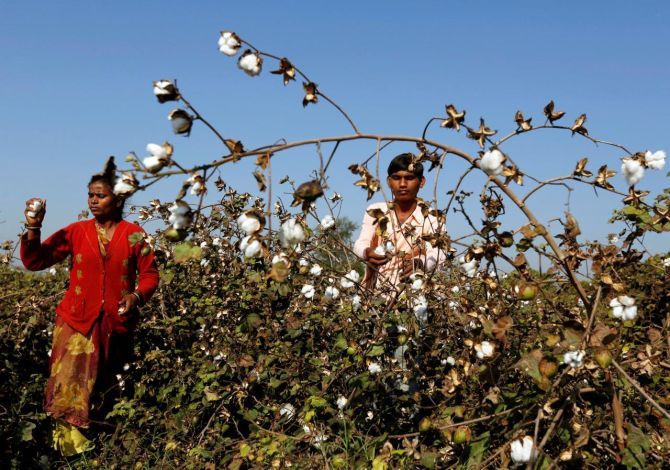Indian cotton and paddy could see their competitiveness in international markets take a hit

As the Centre looks to increase the minimum support price (MSP) of major Kharif crops for the 2018-19 season, one big question is the impact that this will have on the export competitiveness of crops such as paddy and cotton -- which of late have seen a surge in demand due to favourable global factors.
Going forward, most experts and market watchers feel that while there might not be a big dent in exports or export competitiveness of Indian cotton and paddy immediately, these products might become noncompetitive if prices in the international markets fall from their current levels.
This, in turn, could further dent farmers' income, which has already seen a slow growth in the past few years.
The MSP of the medium staple cotton variety for the 2017-18 season is Rs 4,020 per quintal, while that of the long staple variety is Rs 4,320 per quintal.
This was 4.1 per cent and 3.8 per cent more, respectively, than the MSPs fixed for the previous years.
While nothing has been officially declared, most experts said that assuming that the Centre sticks to its promise of announcing an MSP that is 50 per cent more than the A2+FL cost, the new MSP of medium staple cotton for the 2018-19 season could be somewhere around Rs 5,100 a quintal, while that of the long staple variety would be somewhere around Rs 5,400 a quintal.
Trade sources said that even if the MSP of kapas in terms of cotton is around Rs 5,450 a quintal, it will still be lower than the prevailing international price of US cotton - which comes to Rs 145-150 a kilogramme while that of Indian cotton would be somewhere around Rs 132-135 a kilogramme.
Cotton prices in the domestic markets have moved sharply in the past few months due to good global demand and some concerns over planting.
In a recent note, ratings agency ICRA said that the surge witnessed in domestic cotton prices - from Rs 115 a kg in March-April 2018 to Rs 134 per kg in June 2018 for the Shankar 6 variety - in recent months augurs well for the profitability of the domestic spinning sector in the near term.
As a result, the trend of recovery in profitability, which started in Q4 FY2018 after two consecutive weak quarters, is expected to gain momentum during H1 FY2019.
"The improvement is expected to be stronger for well-stocked spinners, which were able to build-up low-cost cotton reserves in the month of December 2017 when domestic cotton prices had dipped temporarily, bringing down their overall weighted average raw material costs," Jayanta Roy, senior vice-president and group head, corporate sector ratings, ICRA Ltd, said in a statement.
According to ICRA, international cotton prices witnessed a sharp surge and reached four-year-high levels during the six-month period ended May 2018 due to the evolving cotton scenario in China as well as speculative buying in the backdrop of anticipated tightening of the global cotton demand-supply situation.
"While the prices have stabilised in the last week of June 2018 after surging further by 5-6 per cent in the first few weeks of June 2018, these continue to be 10 per cent higher Y-o-Y," ICRA said.
However, in contrast, Indian cotton prices increased at a much slower pace during January-May 2018 amid adequate stocking by spinners during the harvest period, which resulted in the widening of the spread between Indian and international cotton prices to 18 per cent vis-a-vis a normal spread of 2-5 per cent, the ratings agency said.
However, going forward in the coming months, how much this spread sustains remains to be seen as Indian prices are expected to move forward, while there is a possibility that global cotton markets might correct from their recent highs.
If that happens, the export competitiveness of Indian cotton could come under a cloud.
"If the Cotton Corporation of India (CCI) increases its buying at the new MSP to support farmers, then there might be a cascading impact on the domestic market as well," a representative from an international trading firm based in Delhi said.
A similar situation holds true in the case of paddy as well. The freight on board price of Indian non-basmati rice to be exported from the Kandla port is expected to be around $400-410 per tonne - assuming that the MSP is increased by Rs 200 a quintal to Rs 1,750 a quintal for the 2018-19 season, from the existing Rs 1,550 a quintal, for common grade rice.
According to the World Bank pink-sheet, in the month of May, the average global price of Thailand Rice with 25 per cent brokens was around $436 a tonne and that of rice with 5 per cent brokens was around $450 a tonne.
This means that at the current rate, Indian non-basmati rice still has some margin to catch up with international markets.
However, that could be highly temporary given the volatile nature of international markets.
"In the short term, the competitiveness of Indian non-basmati rice might not get impacted due to a hike in MSP rates - particularly for those exported to the Middle East, but it could be different for those sold to African nations," Tejinder Narang, a noted food policy expert, said.
He said that moreover, a high MSP would hurt the government's finances, while it might not make a big impact for exporters unless the government massively increases its annual procurement from an average of 33-34 million tonnes to close to 45 million tonnes in one single year.
Photograph: Amit Dave/Reuters












 © 2025
© 2025